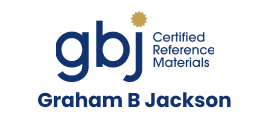Precision oil analysis matters. From lubricant condition monitoring in heavy industry to regulatory testing of fuels and residual oils, reliable elemental data — notably wear and additive metals like Fe, Cu, Pb, Zn and P — drives decisions about maintenance, product quality and compliance. Graham B Jackson Pty Ltd (GBJPL) now supplies the next step in oil-test calibration: hybrid certified reference materials (CRMs) that combine the traceability of aqueous CRMs with the matrix-compatibility of organic solvents. The result: simpler workflows, broader element coverage and cleaner baselines for ICP and ICP-MS oil testing.
What is a “hybrid CRM” — and why it solves a real problem?
Traditionally, oil labs have used either organometallic CRMs (designed to match oil matrices) or aqueous CRMs plus complex sample digestion/extraction. Organometallic CRMs can be expensive, sometimes unstable, and may not cover the full suite of elements labs want to measure. Hybrid CRMs take a pragmatic middle path: labs dilute high-purity aqueous concentrate CRMs into a specially formulated organic solvent (an “oil-compatible” diluent) that contains internal standards. This creates calibration standards that behave more like oil samples on the instrument, while retaining the traceability and low-blank benefits of aqueous CRMs. The approach and supporting protocols were developed and documented by Inorganic Ventures (the manufacturer) and are now available in Australia via Graham B Jackson Pty Ltd (GBJPL) .
How the hybrid method works (practical, repeatable steps)
The hybrid workflow is intentionally straightforward and reproducible:
Prepare two sets of standards from 10× aqueous concentrate solutions — one set in a mild aqueous acid and a second set for more aggressive matrices — then dilute them 1:10 (w/w) into the organic solvent that contains internal standards (e.g., cobalt and yttrium).
The lab uses the resulting neat organic-matrix calibration series (10x→1x dilution) to calibrate ICP/ICP-MS for oil samples. Minimum standard prep sizes and example spreadsheets/templates are provided by the manufacturer to simplify calculations and documentation.
These method details and example preparation worksheets were published in Inorganic Ventures’ application notes and white papers describing the hybrid aqueous/organic CRM approach.
Evidence-based advantages (what labs see in the data)
Hybrid CRMs are not just convenient — they address measurable analytical pain points:
Lower procedural blanks and contamination risk. Because the certified values originate from aqueous concentrates (manufactured and certified under ISO/IEC 17034/17025 frameworks), baseline metallic contaminants are minimized compared with many organometallic mixes.
Broader element compatibility. The hybrid approach allows accurate calibration for elements that are difficult or unstable in organometallic formulations, extending the reliable element list for lubricant and fuel testing.
Cleaner baselines / improved LODs. Using low-blank aqueous concentrates as the source of certified values often improves apparent limits of detection and makes trending of low-level wear metals more robust.
In short: hybrid CRMs pair the metrological strength of established SRMs/CRMs with a solvent system that mimics oil behavior during nebulization and plasma excitation — a practical win for method robustness. (NIST and other reference producers continue to supply official petroleum SRMs; hybrid CRMs provide a complementary, application-focused calibration strategy.)
How hybrid CRMs fit into an accredited QA program
Accreditation-grade testing needs traceability and documented uncertainty. Hybrid workflows preserve both: the assigned values and uncertainty come from the (aqueous) CRM COA, and the dilution/preparation steps are documented in the lab’s calibration and validation files. This makes the approach audit-friendly while improving matrix matching for oils — a pragmatic compromise laboratories can justify in their uncertainty budgets and method validation reports. Suppliers across the industry (LGC, Koehler, Alpha Resources, etc.) continue to produce matrix-matched petroleum CRMs; hybrid CRMs add a flexible, lower-blank option that dovetails with existing QA strategies.
Practical tips for implementation (benchview)
Start with manufacturer worksheets. Use the Excel/calculation templates that accompany hybrid CRM products to avoid stoichiometric or density errors.
Use internal standards present in the solvent. This reduces inter-instrument drift and improves accuracy across the element suite.
Document every dilution by weight (w/w) where possible. Gravimetric prep reduces temperature/volume error and simplifies uncertainty propagation.
Run parallel checks. During method adoption, run organometallic-based calibrations or NIST petroleum SRMs alongside hybrid standards to demonstrate equivalence and build auditor confidence.
Who benefits most
Used-oil / condition monitoring labs that need reliable low-level wear-metal trends.
Petroleum QC labs that require multi-element coverage without the handling complexities of unstable organometallics.
R&D groups developing new oil-additive or lubricant formulations and who need flexible calibration options quickly.
Bottom line
Hybrid CRMs are a practical, data-backed advance for oil testing: they preserve the metrological pedigree of certified aqueous concentrates while delivering a calibration matrix that behaves like oil on ICP instruments. That combination reduces blank-related noise, broadens element coverage and simplifies documentation — all without forcing labs to choose between pure metrology and practical matrix matching. Graham B Jackson Pty Ltd (GBJPL) supplies these hybrid solutions and the supporting technical materials (white papers, prep worksheets and local support) so Australian labs can adopt the method with confidence.
For Further Enquiry Contact: sales@gbjpl.com.au
